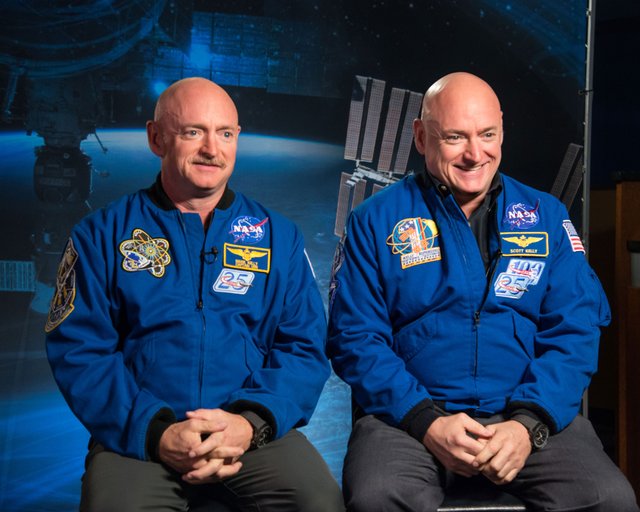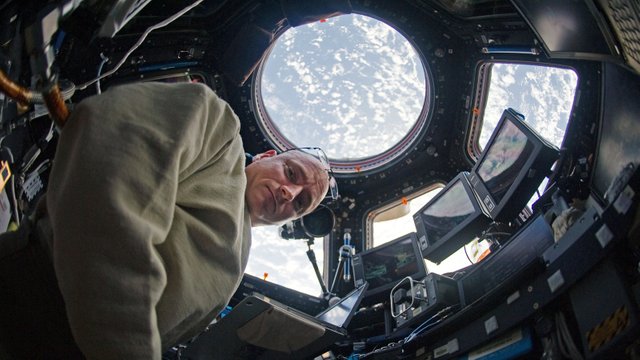NASA studied two twin brothers, one on Earth and one in space, and there are already results/La NASA estudió a dos hermanos gemelos, uno en la Tierra y otro en el espacio y ya hay resultados

Source
On March 27, 2015, NASA's study of twins began. Astronaut Scott Kelly launched to the International Space Station (ISS) and spent 340 days in space until returning to Earth on March 1, 2016. Meanwhile, his identical twin brother, Mark Kelly, remained on Earth. Scientists collected baseline data on both twins before the mission and continued monitoring them during Scott's year on the ISS.
El 27 de marzo de 2015 daba comienzo el estudio de la NASA sobre dos gemelos, el astronauta Scott Kelly fue enviado a la estación espacial internacional IEE) y pasó 340 días en el espacio hasta regresar a la Tierra el 1 de marzo de 2016. Mientras tanto su hermano gemelo idéntico, Mark Kelly, permaneció en la Tierra. Los científicos recogieron datos de referencia de ambos gemelos antes de la misión y continuaron monitorizándolos durante el año de Scott en la EEI.
They then followed up with extensive data collection for months and even years after their return to Earth to see how their bodies readjusted and identify any long-term effects. The results, published in multiple scientific studies, revealed a series of fascinating and, in some cases, surprising changes, which I describe below.
Posteriormente realizaron un seguimiento con una extensa recopilación de datos durante meses e incluso años después de su regreso a la Tierra para ver cómo se readaptaba su cuerpo e identificar cualquier efecto a largo plazo. Los resultados, publicados en múltiples estudios científicos, revelaron una serie de cambios fascinantes y, en algunos casos, sorprendentes que os relato a continuación.

Source
Changes in Scott's gene expression were observed during his time in space. Most of these changes returned to normal upon his return to Earth, but a small percentage persisted even six months later. The astronaut's telomeres (the protective ends of chromosomes) lengthened strikingly during spaceflight, but returned to their normal length shortly after returning to Earth, and some even shortened more than normal in the following months.
Se observaron cambios en la expresión genética de Scott durante su tiempo en el espacio. La mayoría de estos cambios volvieron a la normalidad a su regreso a la Tierra, pero un pequeño porcentaje persistió incluso seis meses después. Los telómeros del astronauta (que son los extremos protectores de los cromosomas) se alargaron sorprendentemente durante el vuelo espacial, pero volvieron a su longitud normal poco después de regresar a la Tierra, e incluso algunos se acortaron más de lo normal en los meses siguientes.
As for his immune system, Scott showed signs of being "on high alert" during his time in space. Although he responded normally to a flu vaccine administered on the ISS, some immune system markers remained elevated even after his return. Furthermore, changes in the composition of his gut microbiome occurred in space.
En cuanto al sistema inmunológico, Scott mostró signos de estar "en alerta máxima" durante su estancia en el espacio, aunque respondió normalmente a una vacuna contra la gripe administrada en la EEI, algunos marcadores de su sistema inmunológico permanecieron elevados incluso después de su regreso. Además se produjeron cambios en la composición del microbioma intestinal en el espacio.

Source
Overall, Scott's cognitive performance remained largely unchanged during spaceflight, although a decrease in his speed and accuracy was observed on cognitive tests after landing. He also experienced a decrease in body mass in space, and changes in his blood vessels, such as a thickening of the carotid artery, and changes in the structure of his eyes, which affected his vision, were also observed.
En general, el rendimiento cognitivo de Scott se mantuvo en gran medida sin cambios durante el vuelo espacial, aunque se observó una disminución en su velocidad y precisión en las pruebas cognitivas después de aterrizar. También experimentó una disminución de la masa corporal en el espacio y también se observaron cambios en sus vasos sanguíneos, como un engrosamiento de la arteria carótida, y cambios en la estructura de sus ojos, lo que afectó su visión.
In summary, the twin study demonstrated the human body's remarkable ability to adapt to the harsh environment of space. While many changes occurred during the year in space, most of them reverted to pre-flight levels in the months following Scott's return to Earth. However, some changes persisted, and research continues to fully understand the long-term implications of spaceflight on human health.
Resumiendo, el estudio de los gemelos demostró la notable capacidad del cuerpo humano para adaptarse al duro entorno del espacio. Si bien se produjeron muchos cambios durante el año en el espacio, la mayoría de ellos revirtieron a los niveles pre-vuelo en los meses posteriores al regreso de Scott a la Tierra. Sin embargo, algunos cambios persistieron, y la investigación continúa para comprender completamente las implicaciones a largo plazo del vuelo espacial en la salud humana.
More information/Más información
https://www.ladbible.com/news/science/nasa-identical-twin-experiment-results-mark-scott-kelly-724025-20250326
Hi, @mauromar,
Your post has been manually curated!
Thx
NASA will never fail to actually give us new update and Development in the science world and if you will ask me, you will actually agree with me that they are really doing a very great job every blessed time